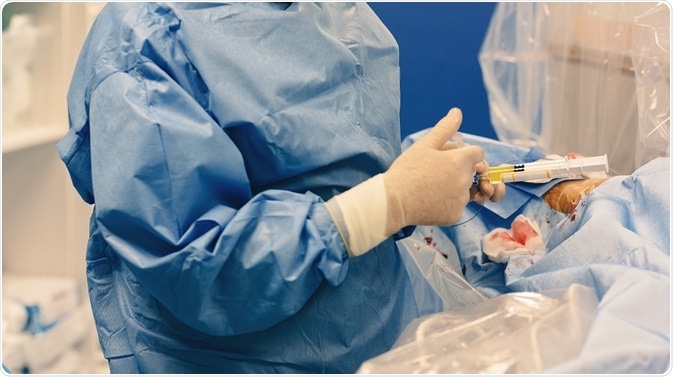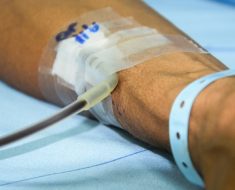Fibroids are uterine growths originating in the smooth muscle. They are often symptomless; however, when they grow, or if they are in certain locations, they produce symptoms ranging from infertility, miscarriage, excessive menstrual bleeding, to interference with urinary bladder function, or constipation.
 Credit: MADvertise/ Shutterstock.com
Credit: MADvertise/ Shutterstock.com
Symptomatic fibroids are treated traditionally by hysterectomy or myomectomy. However, in recent years uterine artery embolization has come to the fore as a successful alternative to surgical management of symptomatic fibroids.
Procedure
Uterine artery embolization (UAE) refers to the procedure in which the branch of the uterine artery that supplies a fibroid is blocked by foreign material. It is also called uterine fibroid embolization (UFE). UAE is performed by interventional radiologists, and was first described in 1995. A catheter is introduced into the femoral artery, and guided upward into the internal iliac and finally into the uterine artery.
The agent used to produce an embolism or block is then injected into the uterine artery through the catheter. This causes the fibroids to lose their blood supply and shrink. Being a new procedure, several professional medical associations have prepared guidelines for UAE.
The first agent used for UAE was polyvinyl alcohol beads with a cap of gelatin sponge. Nowadays, calibrated microspheres are used, which are of even size and make the technique easier to apply. The whole length of the uterine artery should not be blocked but only those branches which supply the fibroid. This will preserve normal uterine tissue as far as possible.
Effectiveness
Several trials show that fibroid embolization is comparable to surgery (hysterectomy or myomectomy) with regards to patient satisfaction.
Hysterectomy is associated with a complication rate of 17-23% but guarantees that fibroids will not recur. However, it also removes all possibility of fertility and has been associated with negative psychological effects on the women who undergo it.
Myomectomy or fibroid removal, on the other hand, is performed on women who want to remain fertile and who do not want their uterus removed. It is not suitable for all types or locations of fibroids. It may be done via open surgery or using keyhole techniques, but the latter may be unsuccessful and require an emergency open surgical rescue if significant hemorrhage occurs.
Again, myomectomy does not remove the possibility of fibroid recurrence. A repeat surgery may become necessary in anywhere from 5-51% of patients. These drawbacks have made it less popular than hysterectomy in the management of fibroids.
Following UAE, fibroid shrinkage occurs by 42-83%, while menorrhagia was reduced in over 80-90% of patients. Pain associated with fibroids was relieved in almost 80% and other symptoms such as urinary retention and constipation improved in about 80-92% of patients. Finally, over 90% and even 97% of patients reported satisfaction with the results of UAE.
Complications
The rate of major complications of fibroid embolization was also comparable with that following surgery, at 1.25%. In addition, it was associated with a shorter procedure time and hospital stay duration, lower chances of requiring a blood transfusion, and faster resumption of normal activities (in about 10 days compared to over 30 days for hysterectomy).
The total complications following UAE were higher, about 10.5%. More patients required unplanned readmission and repeat surgeries following UAE. For this reason, there was no overall reduction in treatment costs. However, some studies show that the rate of complications is halved following UAE.
The most common major complications include:
- Pulmonary embolism where a clot is lodged in the arteries of the lung, causing the blood supply to be cut off
- Bilateral iliac artery thrombosis or clotting
- Uterine inflammation or endometritis
- Infection in less than 1% which could cause sepsis and lead to emergency removal of the uterus
- Heavy bleeding from the uterus
- Prolapse of a large fibroid which is trying to pass through the cervix and vagina to the outside (2.5%), especially with a submucosal fibroid
- Requiring hysterectomy after UAE, mostly because of infection, heavy bleeding, severe pain following embolization (the three often occur together), in 0.25-1.5% of patients
- Amenorrhea or stoppage of menstrual periods, either permanent or temporary, mostly in women over the age of 50 years
Contraindications
UAE should not be performed in women with current infection of the reproductive tract and preferably not in those who wish to conceive following the procedure.
Effects on fertility are not yet established, though one study showed a very poor reproductive outcome following UAE. A single randomized controlled trial showed surgery to be much better in respect to reproductive efficacy, compared to UAE, in early pregnancy, but in later pregnancy, the two types of procedures were quite comparable in their complication rate, such as fetal growth restriction, preterm delivery and malpresentation.
Sources
- https://www.ncbi.nlm.nih.gov/pubmed/22592701
- https://www.ncbi.nlm.nih.gov/pmc/articles/PMC1949124/
- https://www.ncbi.nlm.nih.gov/pmc/articles/PMC3036203/
- https://www.ncbi.nlm.nih.gov/pubmed/11192931
- https://www.ncbi.nlm.nih.gov/pmc/articles/PMC4309148/
- https://www.ncbi.nlm.nih.gov/pmc/articles/PMC3835459/
- https://www.ncbi.nlm.nih.gov/pmc/articles/PMC4074023/
Further Reading
- All Uterine Fibroids Content
- Uterine Fibroids – What are Uterine Fibroids?
- Uterine Fibroids Location
- Uterine Fibroids Treatment
- Uterine Fibroids Malignancy
Last Updated: Feb 27, 2019

Written by
Dr. Liji Thomas
Dr. Liji Thomas is an OB-GYN, who graduated from the Government Medical College, University of Calicut, Kerala, in 2001. Liji practiced as a full-time consultant in obstetrics/gynecology in a private hospital for a few years following her graduation. She has counseled hundreds of patients facing issues from pregnancy-related problems and infertility, and has been in charge of over 2,000 deliveries, striving always to achieve a normal delivery rather than operative.
Source: Read Full Article





